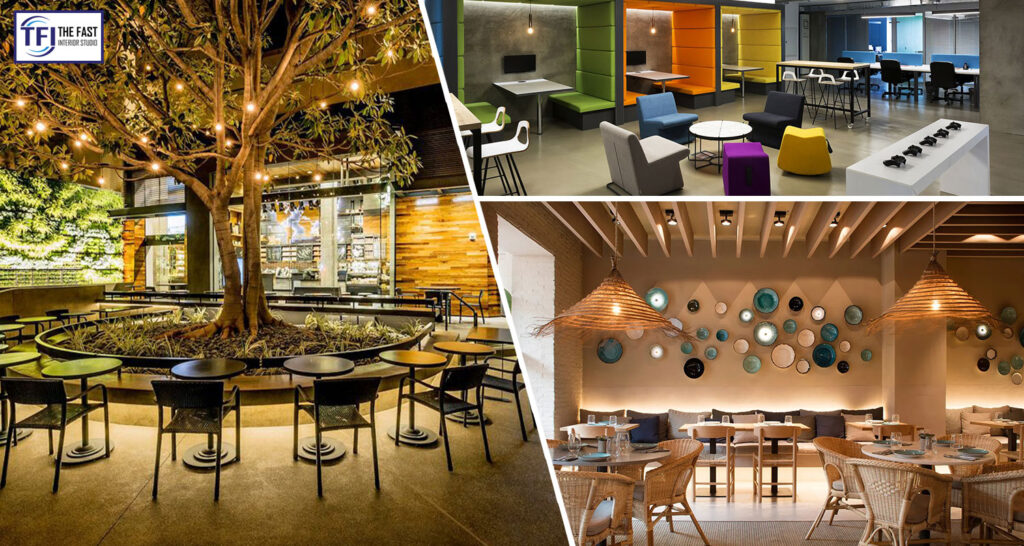Merging Aesthetics and Functionality in Restaurant Design & Ambience

In the realm of restaurant design, the interplay between aesthetics and functionality is a delicate dance, creating spaces that not only please the eye but also serve a purpose. A well-designed restaurant interior can elevate the dining experience, making customers feel not just satisfied but immersed in a carefully curated atmosphere. Let’s delve into the art of merging aesthetics and functionality to unveil the secrets behind successful restaurant design. Creating a Visual Feast: The Aesthetics of Restaurant Design When patrons step into a restaurant, the first thing that captivates them is the visual appeal. Aesthetics play a crucial role in setting the tone and creating a memorable impression. From the color scheme to the furniture choices, every element contributes to the overall ambiance. Choosing the Right Palette: The restaurant’s color palette is like a canvas that sets the mood. Warm tones like reds and oranges evoke a cozy, intimate atmosphere, while cool blues and greens create a refreshing and modern feel. Striking the right balance is key. Furniture as Art: Restaurant interior design isn’t just about tables and chairs; it’s about functional art. Furniture should not only complement the overall theme but also provide comfort. Elegant and comfortable seating encourages guests to linger, enjoying their dining experience. Lighting Magic: Lighting is the unsung hero of restaurant decor. The right lighting can highlight architectural features, create intimacy, and even influence appetite. Whether it’s pendant lights, wall sconces, or ambient lamps, each fixture plays a role in sculpting the desired ambiance. Functionality: Where Form Meets Purpose Aesthetics alone, however, do not make a restaurant successful. Functionality is equally crucial, ensuring that the space is not only beautiful but practical for both customers and staff. Flow of Space: A well-designed restaurant considers the flow of space. From the entrance to the seating area and the restrooms, each section should seamlessly connect, allowing for easy navigation. This not only enhances the customer experience but also improves operational efficiency. Optimizing Seating Arrangements: The arrangement of tables and chairs is a critical aspect of functionality. Adequate spacing ensures that guests don’t feel cramped, and servers can move efficiently. Balancing intimacy with capacity is the key to maximizing the use of space. Kitchen Efficiency: Behind the scenes, the restaurant interior design extends to the kitchen. An efficiently designed kitchen layout can enhance productivity, minimize wait times, and contribute to the overall success of the establishment. Harmony in Design: The Intersection of Aesthetics and Functionality The magic of restaurant design lies in achieving a seamless harmony between aesthetics and functionality. It’s not about choosing one over the other but finding a perfect balance that enhances the overall dining experience. Theme Integration: A well-thought-out theme can bring together the aesthetic and functional elements. Whether it’s a rustic farmhouse feel or a sleek modern vibe, the theme should be reflected not only in decor but also in the layout and operational aspects. Branding through Design: Restaurant design is a powerful tool for branding. Consistent aesthetics across multiple locations create a recognizable brand identity. From the color scheme to the choice of materials, every detail contributes to building a cohesive brand image. Adaptability for Success: The restaurant industry is dynamic, and successful designs embrace adaptability. Flexibility in layout and decor allows restaurants to evolve with changing trends and customer preferences, ensuring long-term success. Conclusion: Elevating the Dining Experience In the world of restaurant design, the merging of aesthetics and functionality is an ongoing process. It’s about creating spaces that not only captivate the eye but also enhance the overall dining experience. From the careful selection of colors and furniture to the thoughtful consideration of space and efficiency, every element plays a vital role. As the restaurant industry continues to evolve, the importance of finding that perfect balance between aesthetics and functionality remains at the heart of successful restaurant design.
9 to 5 Strategies | Optimizing Office Workspace Design

In today’s fast-paced work environment, the traditional 9-to-5 grind is getting a facelift. Employers are realizing the importance of optimizing office workspace design to enhance employee productivity and well-being. Let’s explore some practical strategies to transform your workspace into a hub of efficiency and inspiration. If you have a keen interest in designing or redesigning your office workspace, The Fast Interior Studio DHA stands out as the optimal choice for you. 1. Flexible Seating Arrangements: Gone are the days of rigid cubicles. Embrace the trend of flexible seating arrangements that empower employees to choose where they work best. From open collaboration spaces to quiet corners for focused tasks, the office becomes a dynamic environment tailored to individual needs. 2. Ergonomic Essentials: Investing in ergonomic furniture is more than a trend; it’s a necessity. Comfortable chairs, adjustable desks, and proper lighting not only boost physical well-being but also contribute to increased concentration and output. Happy bodies lead to happy minds. 3. Green Oasis in the Office: Integrating greenery into the workspace is more than a visual enhancement. Plants improve air quality, reduce stress, and create a refreshing atmosphere. A touch of nature can do wonders for both workplace ambience and employee morale. 4. Embrace Natural Light: Say goodbye to the harsh glow of artificial lighting. Make the most of natural light sources to create a vibrant and energetic office environment. Position workspaces strategically to maximize exposure to sunlight, promoting alertness and a positive mood. 5. Personalized Workstations: Encourage employees to personalize their workstations. A touch of personal flair not only adds character to the office but also fosters a sense of ownership and belonging. Happy and comfortable employees are more likely to be engaged and productive. 6. Tech Integration: In the digital age, seamless tech integration is key to a successful office. Ensure that workspaces are equipped with the latest technology to facilitate smooth collaboration, communication, and task management. A technologically advanced workspace keeps everyone connected and on the same page. 7. Dynamic Collaboration Zones: Designate specific areas for collaboration, equipped with interactive whiteboards and comfortable seating. These zones foster teamwork, creativity, and the free exchange of ideas. A well-designed collaborative space enhances workplace ambience and encourages a culture of innovation. 8. Noise Management: A quiet workspace is a productive workspace, but complete silence isn’t always realistic. Implement noise management strategies, such as acoustic panels and designated quiet areas, to strike the right balance. A peaceful office ambience allows employees to concentrate without unnecessary distractions. 9. Breakout Spaces for Relaxation: Recognize the importance of downtime by creating dedicated breakout spaces. Comfortable seating, games, and even a well-stocked kitchenette contribute to a relaxed atmosphere. Employees returning to their tasks after a brief break tend to be more focused and creative. 10. Regular Workspace Assessments: Office workspace design is not a one-time task. Regularly assess and reassess the effectiveness of the current design. Solicit feedback from employees to identify areas for improvement. A workspace that evolves with the needs of its occupants is a workspace that thrives. 11. Emphasis on Wellness Programs: Integrating wellness programs into the office routine can significantly impact employee health and satisfaction. Consider offering yoga classes, meditation sessions, or even a fitness area. A healthy body and mind contribute to improved focus, creativity, and overall workplace ambience. 12. Streamlined Organization: A cluttered workspace can lead to mental clutter. Implement smart storage solutions to keep the office organized and visually appealing. A tidy environment not only enhances the office’s aesthetic but also promotes a more efficient workflow. 13. Inclusive Design for Diversity: Office workspace design should cater to a diverse workforce. Create spaces that accommodate different work styles and needs, fostering inclusivity. Consider standing desks, accessible furniture, and varied seating options to ensure everyone feels comfortable and valued. 14. Encourage Face-to-Face Interaction: While digital communication is essential, face-to-face interactions remain invaluable. Design communal areas where employees can gather, share ideas, and build relationships. Personal connections contribute to a positive office ambience, promoting a sense of unity and collaboration. 15. Artistic Touches: Integrating art into the workspace adds vibrancy and creativity. Whether it’s murals, sculptures, or local artwork, visual stimuli can inspire and energize employees. Artistic touches contribute to a unique office ambience, making the workspace a place that employees enjoy spending time in. 16. Employee Input in Design Decisions: Empower employees by involving them in the office design process. Seek their input on color schemes, furniture choices, and layout preferences. This not only ensures that the workspace meets their needs but also fosters a sense of ownership and pride in the workplace. 17. Sustainable Design Practices: Embrace Eco-friendly office design by incorporating sustainable materials, energy-efficient lighting, and recycling stations. Demonstrating a commitment to environmental responsibility not only aligns with modern values but also contributes to a positive workplace ambience. 18. Remote Work Considerations: In the era of flexible work arrangements, design the office with remote work in mind. Create spaces that accommodate both in-person and virtual collaboration, fostering connectivity regardless of physical location. A workspace that seamlessly integrates remote work supports a modern and adaptable work culture. 19. Celebrate Milestones and Achievements: Designate spaces to celebrate team accomplishments, milestones, and individual successes. Recognizing achievements contributes to a positive office ambience and reinforces a culture of appreciation and motivation. 20. Continuous Learning Spaces: Foster a culture of continuous learning by creating spaces for training sessions, workshops, and knowledge-sharing. These spaces not only enhance professional development but also contribute to a dynamic and forward-thinking workplace ambience. In summary, optimizing office workspace design involves a holistic approach that considers physical, mental, and emotional well-being. By incorporating these additional strategies, businesses can create an environment that not only supports productivity but also reflects a commitment to employee satisfaction and success. A thoughtfully designed workspace is a powerful tool for attracting and retaining top talent while fostering a culture of innovation and collaboration.

